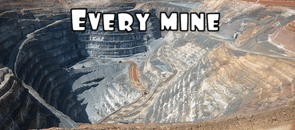Important: Click Refresh Map Button if Google Map is not displayed above Follow these steps: Create a KML File: Use the GPS coordinates of the boundary pillars to create a mine boundary KML file. You can use the proprietary KOMPAS application, the Mine Mapper App, or the tool provided on this website. Ensure the coordinates are in the DD:MM:SS.SSSS format. Load the KML File: Once you have created the KML file, load it into the application. Click the full screen button on the map (refer image below). Perform Measurements: The application will calculate various measurements such as the length of sides, mine area, and mining area, considering a 7.5-meter buffer as per Metalliferous Mines Regulations. Analyze Buffer Lines: The application will draw buffer lines at specific distances: 50 meters (statutory distance for structures), 150 meters (NGT-prescribed distance), 500 meters (to assess cluster situations), and 1 kilometer (no mining within this distance from Wildlife Sanctuaries and National Parks). Each line is color-coded for easy identification. Use Measurement Tools: Utilize the provided measurement tools to assess distances from structures and calculate areas. You can also display the length of the sides of the polygon. Review Pillar Data: The application provides pillar numbers and elevations (SRTM elevation, which approximates toposheet elevation). Analyse the topography: You can also view elevations of points at 30-meter intervals and check the contour lines provided in the mining plan. Note that there is the option to hide grid elevation (may be helpful while taking length and area measurements. Viewing live location: If this application is used in a mobile device having GPS, then the user can see the live locations on the map. The user may check the correctness of the coordinates of pillars, see whether mining took place outside the lease area or in the non-mining area (7.5 m buffer). Users can see the correct locations of the structures like buildings, roads etc. Drawing Sections: The sections (profile) can be drawn using the line drawing tool. Before drawing the section, change the "Drawing Mode" to "Profile Mode" by clicking the Mode switching button. Then draw a straight line (click first point, then click second point and then complete drawing by clicking the hand icon or click first point and then double click the second point). The elevation values will be plotted at an interval of 5 m. The chart generated can be expanded. Accuracy Warning: The accuracy of the measurements depends on how the latitude and longitudes of the boundary pillars are collected. The length and area measurements may be slightly different from actual as GIS based analysis has its own limitations. Always prefer DGPS/Total Station survey for better results. Additional Help: Refer following image for further guidance on using specific features or tools.
Area Measurment with length of sides using polygon tool Area measurement without length of sides Length measurement using line tool Color coded buffer lines
 |
| Drawing the profile by toggling the drawing mode to profile mode |
Disclaimer: The information on this website is provided "as is" and "without warranty." In terms of how this information is used or the results of its usage, the author disclaims all liability.
(c) Biju Sebastian 2024



















0 Comments